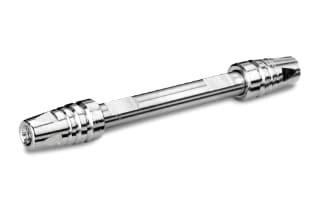
|
Chemistry |
C18 |
|
Separation Mode |
Reversed Phase |
|
Particle Substrate |
Silica |
|
pH Range Min |
2 pH |
|
pH Range Max |
8 pH |
|
Temperature Limits |
45 C |
|
Maximum Pressure |
18000 psi (1240 Bar) |
|
Endcapped |
No |
|
Bonding Technology |
C18 SB |
|
Silanol Activity |
High |
|
Particle Shape |
Spherical |
|
Particle Size |
1.8 µm |
|
Endfitting Type |
Parker-style |
|
Pore Size |
100 Å |
|
Format |
Column |
|
Surface Area |
230 |
|
System |
UPLC, UHPLC |
|
Particle Technology |
HSS |
|
USP Classification |
L1 |
|
Inner Diameter |
3 mm |
|
Length |
75 mm |
|
Carbon Load |
8 % |
|
eCord |
Yes |
|
UNSPSC |
41115709 |
|
Brand |
ACQUITY UPLC |
|
Product Type |
Columns |
|
Units per Package |
1 pk |

ACQUITY UPLC HSS C18 SB Column, 100Å, 1.8 µm, 3 mm X 75 mm, 1/pk
Reduce the possibility of technique variation brought on by inconsistent batches or columns of the chromatographic medium. Because the ACQUITY UPLC HSS C18 SB Column has been engineered to produce predictable and reproducible results year after year, you can count on it to work consistently.
Utilize the ACQUITY UPLC HSS C18 SB Column's distinctive non-end-capped, low-coverage silica-based C18 chemistry to obtain alternative selectivity for substances that are influenced by silanophilic interactions. Due to secondary interactions with remaining silanols, the lab equipment offers a unique increased silanol activity that causes larger retention of basic chemicals. This occurs as ionic repulsion and poor ligand density reduce retention of non-basic analytes. The ACQUITY UPLC HSS C18 SB Column is a potent method development tool that may impart changes in Selectivity for Bases (SB) while producing excellent peak shape thanks to this unique mix of retention characteristics.
You can explore our website to buy lab equipment, see all the goods that are compatible with the current offering, or find other iterations of the same listing. To assist you in understanding how our equipment functions, the website includes reference materials that go into great detail on our research and development.
The ACQUITY UPLC HSS C18 SB Column's packing materials were created exclusively for use with the ACQUITY UPLC System. Additionally, they are produced in a facility that is ISO 9001 and cGMP certified using ultra-pure reagents. To ensure outstanding, repeatable performance, each batch of the packing material is chromatographically tested with acidic, basic, and neutral analytes. The results are confined to limited specification ranges.
Invest in the ACQUITY UPLC HSS C18 SB VanGuard Pre-column, 100Å, 1.8 µm, 2.1 mm X 5 mm, 3/pk in order to protect your column from unwanted contaminants that interfere with analysis results while enhancing the lifetime of the column. The pre-column is made using the same packing materials as the column.
Are There Any pH Limitations For The ACQUITY UPLC HSS C18 SB Column?
The ACQUITY UPLC HSS C18 SB Column listed here is able to work well across the 2-8 pH range.
What Are The Temperature Limits Of The ACQUITY UPLC HSS C18 SB Column?
This ACQUITY UPLC HSS C18 SB Column is able to tolerate a maximum of 45 C.